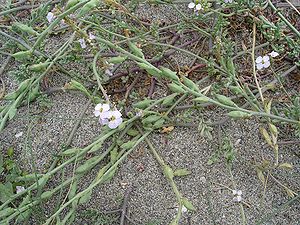Sea mustard
| Sea mustard | ||||||||||||
|---|---|---|---|---|---|---|---|---|---|---|---|---|

|
||||||||||||
| Systematics | ||||||||||||
|
||||||||||||
| Scientific name | ||||||||||||
| Cakile | ||||||||||||
| Mill. |
Sea mustard ( Cakile ) is a genus in the cruciferous family (Brassicaceae).
description
Appearance, roots and leaves
Sea mustard species are usually annual, rarely perennial herbaceous plants that reach heights of up to 0.8 meters. The tap roots can become lignified and have relatively long horizontal lateral roots. They are mostly bare, plump, succulent beach plants. The aboveground parts of the plant are hairless or sometimes sparsely hairy. The erect, ascending, spreading or prostrate stems are branched at their base.
The alternate and spirally arranged leaves on the stem are mostly petiolate and often have a fleshy and simple to double pinnate leaf blade. The leaf margins are smooth, wavy, notched, serrated or serrated. Stipules are missing.
Generative characteristics
Many flowers are in only schirmtraubigen later to fruit ripening elongating by stretching the inflorescence axis traubigen inflorescences together. The stalked, hermaphrodite flowers are fourfold. The four sepals are erect. The four white to purple petals are nailed. There are six stamens . The thick, two-part limb pod is 12 to 27 mm long and contains two to three seeds. The upper pod member is compressed.
The basic chromosome number is x = 9.
Occurrence
The sea mustard species occur mainly in the temperate latitudes of the northern hemisphere . Distribution areas are northern Africa , Europe , the Arabian Peninsula and western Asia as well as North and Central America and the Caribbean . Most species in America grow in salty places such as coastlines , dunes, and salt pans within the country.
The only European and also in Central Europe occurring species is the European sea mustard , which can be found in several subspecies on almost all European sea coasts. The originally North American Cakile edentula , which was introduced to the Azores , is a second species in Europe.
Systematics
The genus Cakile was established in 1754 by Philip Miller in The Gardeners Dictionary ... Abridged ... , fourth edition, Vol. 1. Cakile maritima Scop became the lectotype in 1913 . set. The botanical genus name Cakile is derived from the Arabic name qaqulleh . The genus Cakile belongs to the tribe Brassiceae in the family of Brassicaceae .

There are about six types of Cakile :
- Cakile arabica Velen. & Bornm. : It occurs after Euro + Med in Jordan.
- Cakile constricta Rodman ; Homeland: southern USA (Alabama, Louisiana, Mississippi, Florida, Texas).
- Cakile edentula (Bigelow) Hook. ; Home: Canada, USA, the Azores and Australia a neophyte.
- Cakile geniculata (BLRob.) Millsp. : It occurs on the beach in Louisiana, Texas and Mexico.
- Cakile lanceolata (Willd.) OESchulz ; Homeland: Florida, Mexico, Central America, Colombia and the Caribbean.
- European sea mustard ( Cakile maritima Scop. ); Homeland: Europe, North Africa, Macaronesia and Western Asia, is naturalized in North America.
literature
- J. Gathe: Cakile Online in the Western Australian Flora , 2008. (Section Description)
- James E. Rodman: Cakile in the Flora of North America , Volume 7, 2010, p. 424: Cakile - Online. (Section systematics and description)
Web links
Individual evidence
- ↑ a b c d e Cakile in the Germplasm Resources Information Network (GRIN), USDA , ARS , National Genetic Resources Program. National Germplasm Resources Laboratory, Beltsville, Maryland.
- ^ Warwick SI, Francis A. and Gugel RK (2009): Guide to Wild Germplasm of Brassica and Allied Crops (tribe Brassiceae, Brassicaceae) . Ed .: Multinational Brassica Genome Project. 3. Edition. Ontario 2009, Taxonomic Checklist and Life History, Ecological, and Geographical Data (English, Online PDF 427 kB).
- ↑ Karol Marhold, 2011: Brassicaceae : Datasheet Cakile In: Euro + Med Plantbase - the information resource for Euro-Mediterranean plant diversity.
- ↑ James E. Rodman: Cakile Miller. In: Flora of North America, vol. 7. [1] .
